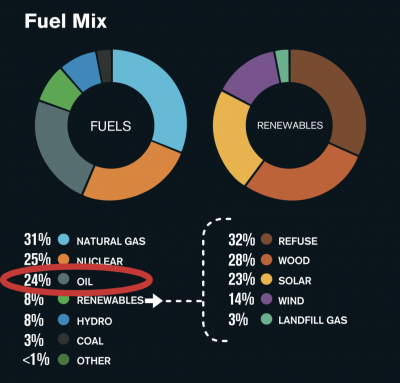All
Once Again, Heating Oil Comes to the Rescue

Industry helped keep the lights on for millions of East Coast homes and businesses
The alert went out on January 11 at 2:00 p.m. ISO New England, the region’s electric grid operator, implemented an “Abnormal Conditions Alert … in ALL OF NEW ENGLAND due to Capacity Deficiency” (emphasis theirs).
Natural gas price spikes — caused by a combination of low temperatures and high demand — prompted the grid operator to bring oil-fueled power generators online. By 4 p.m., distillate and residual fuel oil accounted for 17% of the region’s electricity production.
Once again, heating oil literally helped keep the lights on for millions of New England homes and businesses.
ISO New England spokesperson Matt Kakely told CommonWealth Magazine, “The gas that is available is expensive, which is making coal and oil cheaper than gas units, so they’re being dispatched first.”
Meanwhile natural gas and electric utilities were on damage control, warning public officials in the state of Connecticut about the potential for rotating power outages – a warning ISO New England had first sounded in December 2021, which was reiterated by heating fuel suppliers shortly thereafter in a letter to state governors across the region (see “Heating Industry to Governors: Do Not Repeat Texas’s Tragedy”).  Asked about the alert on the afternoon of January 11, Kakely gave the following statement to Boston 25 News: “We expect to have the resources needed to meet consumer demand and required power system reserves throughout the evening. ISO New England issued this operational alert because today’s cold weather caused unexpected outages at several generating resources and transmission lines. These alerts are not emergency actions, but rather designed to notify the region and resources owners that conditions may be tight on the power system and emergency action may be needed if conditions worsen. ISO New England has called on additional power plants, and these resources are expected to be online ahead of the evening peak for consumer demand, expected between 5 and 6 p.m.”
Asked about the alert on the afternoon of January 11, Kakely gave the following statement to Boston 25 News: “We expect to have the resources needed to meet consumer demand and required power system reserves throughout the evening. ISO New England issued this operational alert because today’s cold weather caused unexpected outages at several generating resources and transmission lines. These alerts are not emergency actions, but rather designed to notify the region and resources owners that conditions may be tight on the power system and emergency action may be needed if conditions worsen. ISO New England has called on additional power plants, and these resources are expected to be online ahead of the evening peak for consumer demand, expected between 5 and 6 p.m.”
In short, oil-fueled power plants came online, allowing the juice to keep flowing. One such plant was Wyman Station in Yarmouth, Maine, which has a total generating capacity of 610 megawatts.
By 10:00 p.m., the grid operator was able to cancel its alert.
Though temperatures continued to drop over the following days, oil supplies kept pace. On Sunday, January 16, when the daily low temperature in Boston reached 5°F, fuel oil accounted for 24% of New England’s power generation.
According to ISO New England’s 21-Day Energy Assessment Forecast and Report from January 18, “17.1 million gallons of oil were consumed for power generation” from January 11 through January 17, including “9.7 million gallons of distillate fuel oil and 7.4 million gallons of residual fuel oil.”
This was a significant increase from the previous seven-day period (January 4 through January 10), when power generators reported consuming 4.45 million gallons of distillate fuel, and an even bigger increase from two weeks prior (December 28 through January 3), when just 0.80 million gallons were consumed. With each status update, ISO New England stated that “replenishment of fuel oil will be critical to ensure that energy supplies remain adequate throughout the remainder of the winter season.”
Of course, the New England states weren’t the only ones turning to fuel oil to keep the lights on. As of January 10, 30% of the New York Independent System Operator’s electricity generation came from dual fuel units that use oil as a backup source. Additionally, some power plants in Maryland were actually eying a future in fuel oil as a cost-effective alternative to rising natural gas prices.
One day after ISO New England issued its alert, The Baltimore Sun reported that two power plants in Anne Arundel County planned to transition from coal to oil in the coming years. Raven Power, which operates both plants, told the Maryland Public Service Commission that the switch would help reduce emissions.
In a meeting about the plan on January 12, William Paul, chief of air quality permits for the Maryland Department of the Environment, voiced support for the plants’ transition from coal to oil-fueled power generation. “This is a project that will result in significant environmental benefits and public health benefits because there’s going to be a dramatic decrease in the amount of regulated air pollutants that are being discharged from this very source,” Paul said.
The commission agreed, ruling unanimously that Raven Power need not obtain a new Certificate of Public Convenience and Necessity to transition its power plants from coal to oil. A permit from the Department of the Environment would still be required, but if Paul’s comments were any indication, that agency’s approval should be forthcoming.
Related Posts
 Thinking about Onsite Storage? Start Here.
Thinking about Onsite Storage? Start Here.
Posted on December 23, 2025
 100 Years of Helping Fuel Retailers Deliver!
100 Years of Helping Fuel Retailers Deliver!
Posted on August 18, 2025
 U.S. Competing to Secure Critical Minerals
U.S. Competing to Secure Critical Minerals
Posted on June 16, 2025
 The Clean Air Act, the EPA, and State Regulations
The Clean Air Act, the EPA, and State Regulations
Posted on May 14, 2025
Enter your email to receive important news and article updates.
